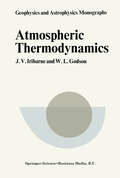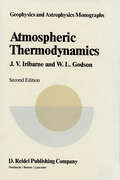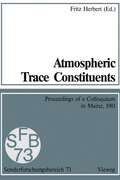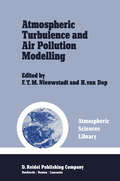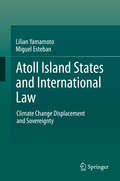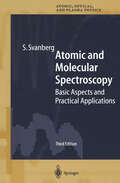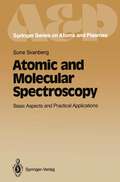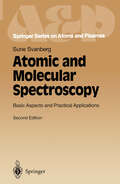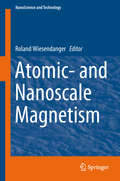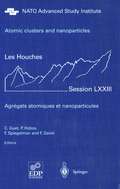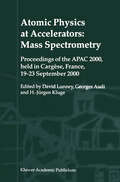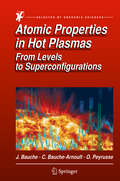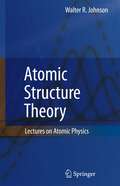- Table View
- List View
Atmospheric Science for Environmental Scientists
by C. Nick Hewitt Andrea V. JacksonEnlightens readers on the realities of global atmospheric change, including global warming and poor air quality Climate change and air pollution are two of the most pressing issues facing Mankind. This book gives undergraduate and graduate students, researchers and professionals working in the science and policy of pollution, climate change and air quality a broad and up-to-date account of the processes that occur in the atmosphere, how these are changing as Man’s relentless use of natural resources continues, and what effects these changes are having on the Earth’s climate and the quality of the air we breathe. Written by an international team of experts, Atmospheric Science for Environmental Scientists, 2nd Edition provides an excellent overview of our current understanding of the state of the Earth’s atmosphere and how it is changing. The first half of the book covers: the climate of the Earth; chemical evolution of the atmosphere; atmospheric energy and the structure of the atmosphere; biogeochemical cycles; and tropospheric chemistry and air pollution. The second half looks at cloud formation and chemistry; particulate matter in the atmosphere; stratospheric chemistry and ozone depletion; boundary layer meteorology and atmospheric dispersion; urban air pollution; and global warming and climate change science. Provides succinct but detailed information on all the important aspects of atmospheric science for students Offers the most up-to-date treatment of key issues such as stratospheric chemistry, urban air pollution, and climate change Each chapter includes basic concepts, end-of-section questions, and more in-depth material Features contributions from the best experts and educators in the field of atmospheric science Atmospheric Science for Environmental Scientists, 2nd Edition is an invaluable resource for students, teachers, and professionals involved in environmental science. It will also appeal to those interested in learning how the atmosphere works, how humankind is changing its composition, and what effects these changes are leading to.
Atmospheric Science for Environmental Scientists
by C. Nick Hewitt Andrea V. JacksonClimate change and air quality are two of the most pressing issues facing Mankind. This book gives undergraduate and graduate students and professionals working in the science and policy of pollution, climate change and air quality a broad and up-to-date account of our understanding of the processes that occur in the atmosphere, how these are changing as Man’s relentless use of natural resources continues and what effects these changes are having on the Earth’s climate and the quality of the air we breath. Written by an international team of experts, this text gives an excellent overview of our current understanding of the state of the Earth’s atmosphere and how it is changing. It is an invaluable resource for students, teachers and professionals. Key features: End of chapter questions Each chapter includes both basic concepts and more in-depth material, allowing faculty to direct students accordingly Most up-to-date treatment of key issues such as stratospheric chemistry, urban air pollution, and climate change
Atmospheric Temperature Profiles of the Northern Hemisphere: A Compendium of Data (Springer Atmospheric Sciences)
by Young Yee Kueyson Y. Yee Erik Y. YeeFor more than three decades, the US Standard Atmosphere has been used by researchers and professionals in many areas of aeronautics and atmospheric sciences. It is an idealized, all season average temperature profile of the earth's atmosphere. But today's modern day and sophisticated global applications require more extensive representations of the mean temperature profile. This book is a global augmentation of the climatological tropospheric temperature profiles in the Northern Hemisphere for different latitude belts and seasons. There are 72 mean temperature profile tables from the surface up to 10 kilometers in height that represent the four seasons for different latitudinal belts (5° N, 10° N , 15° N, 20° N, 25° N, 30° N, 35° N, 40° N, 45° N, 50° N, 55° N, 60° N, 65° N, 70° N, 75° N, 80° N, 85° N). The model is based on a neural network algorithm that uses archived radiosonde data, retrieved temperature profiles from remote sensors, and the solar insolation at the top of the earth's atmosphere. It is the most comprehensive book of mean seasonal tropospheric temperature profiles to date. It will be an indispensible reference to the aeronautic and meteorological industries worldwide as well as an easy-to-use guide for climatologists, meteorologists, aeronautic engineers, researchers and aviators.
Atmospheric Thermodynamics
by J. V. IribarneThe thermodynamics of the atmosphere is the subject of several chapters in most textbooks on dynamic meteorology, but there is no work in English to give the subject a specific and more extensive treatment. In writing the present textbook, we have tried to fill this rather remarkable gap in the literature related to atmospheric sciences. Our aim has been to provide students of meteorology with a book that can playa role similar to the textbooks on chemical thermodynamics for the chemists. This implies a previous knowledge of general thermodynamics, such as students acquire in general physics courses; therefore, although the basic principles are reviewed (in the first four chapters), they are only briefly discussed, and emphasis is laid on those topics that will be useful in later chapters, through their application to atmospheric problems. No attempt has been made to introduce the thermodynamics of irreversible processes; on the other hand, consideration of heterogeneous and open homogeneous systems permits a rigorous formulation of the thermodynamic functions of clouds (exclusive of any consideration of microphysical effets) and a better understanding of the approx imations usually implicit in practical applications.
Atmospheric Thermodynamics (Geophysics and Astrophysics Monographs #6)
by Julio V. Iribarne W. L. GodsonThe thermodynamics of the atmosphere is the subject of severai chapters in most textbooks on dynamic meteorology, but there is no work in English to give the subject a specific and more extensive treatment. In writing the present textbook, we have tried to fiII this rather remarkable gap in the literature related to atmospheric sciences. Our aim has been to provide students of meteorology with a book that can play a role similar to the textbooks on chemical thermodynamics for the chemists. This implies a previous knowledge of general thermodynamics, such as students acquire in general physics courses; therefore, although the basic principles are reviewed (in the urst four chapters), they are only briefly discussed, and emphasis is laid on those topics that wilI be useful in later chapters, through their application to atmospheric problems. No attempt has been made to introduce the thermodynamics ofirreversible processes; on the other hand, consideration of heterogeneous and open homogeneous systems permits a rigorous formulation of the thermodynamic functions of c10uds (exclusive of any consideration of microphysical effects) and a better understanding of the approx imations usually implicit in practical applications.
Atmospheric Tidal and Planetary Waves (Atmospheric and Oceanographic Sciences Library #12)
by Hans VollandPrior to the space age, meteorologists rarely paid particular attention to the height regions above the tropopause. What was known about the upper atmosphere above about 100 km came essentially from ionospheric and geomagnetic research. The region in between, presently known as the middle atmosphere, was almost terra incognita above the height reachable by balloons. It was space research that allowed for the first time direct access to middle and upper atmospheric heights. About 40 years ago, Sidney Chapman coined a new word 'aeronomy' to describe the study of these two height regions. When asked about the difference between aeronomy and meteorology, he allegedly replied: 'it is the same as between astronomy and astrology' . This mild irony indicates the preferred prejudice of many ionospheric physicists and geomagneticians in those days toward meteorology as a descriptive rather than an exact science, in spite of the presence of such giants as Carl Rossby and Hans Ertel.
Atmospheric Tides: Thermal and Gravitational
by S. Chapman R.S. LindzenEveryone is familiar with the daily changes of air temperature. The barometer shows that these are accompanied by daily changes of mass distribution of the atmosphere, and consequently with daily motions of the air. In the tropics the daily pressure change is evident on the barographs; in temperate and higher latitudes it is not noticeable, being overwhelmed by cyclonic and anticyclonic pressure variations. There too, however, the daily change can be found by averaging the variations over many days; and the same process suffices to show that there is a still smaller lunar tide in the atmosphere, first sought by Laplace. Throughout nearly two centuries these 'tides', thermal and gravitational, have been extensively discussed in the periodical literature of science, although they are very minor phenomena at ground level. This monograph summarizes our present knowledge and theoretical under standing of them. It is more than twenty years since the appearance of the one previous monograph on them - by Wilkes - and nearly a decade since they were last comprehensively reviewed, by Siebert. The intervening years have seen many additions to our know ledge of the state of the upper atmosphere, and of the tides there, on the basis of measurements by radio, rockets and satellites.
Atmospheric Trace Constituents: Proceedings of the 5th Two-Annual Colloquium of the Sonderforschungsbereich 73 of the Universities Frankfurt and Mainz and the Max-Planck-Institut Mainz, Held in Mainz, Germany, on 1 July 1981
by Fritz HerbertThis colloquium on Atmospheric Trace Constituents held in Mainz on July 1, 1981, was a joint one-day meeting of all scientific working groups of the SFB-73. The purpose of this meeting was to provide a fairly intensive and comprehensive review of the SFB-73 research work during the last two years and to discuss the state and the problems as well as possible future developments of the various projects. According to the scientific program of the SFB, the meeting consisted of two separate sessions devoted to actual research problems of trace gases (session I) as well as aerosol particles (session II) in the atmospheric environment. As in previous years, each of the 14 partial projects presented its efforts at least by one research contribution. In nearly twenty papers and discussions, methods, results and the present state of art as well as particularly numerous open questions in the experimental and theoretical studies could be explained. The range of topics considered can be gauged from the contents of this publication. The proceedings contain almost all papers presented at the colloquium. These papers have been issued as quickly as possible. Most of the authors devoted considerable efforts to keep within tight time and space deadlines. It is a pleasure to acknowledge these efforts here. A few number of papers, however, could only be re· ceived with a considerable time extension and this unfortunately caused an editorial delay of several months.
Atmospheric Turbulence (Routledge Revivals)
by O.G. SuttonOriginally published in 1955 Atmospheric Turbulence examines dynamic meteorology and the fundamental part it plays in the overall science of meteorology. The book examines the theory of atmospheric turbulence as a more mathematically developed area than largescale motions of the atmosphere and examines its significance in economic, military and industrial spheres. The book focuses on the effect and importance of atmospheric turbulence, not only to meteorologists, but the designers of large aircraft. The book addresses the effects of turbulence and the properties of the atmosphere that can be found closer to the ground. This book will be of interest to atmospheric physicists and meteorologists.
Atmospheric Turbulence (Routledge Revivals)
by O.G. SuttonOriginally published in 1955 Atmospheric Turbulence examines dynamic meteorology and the fundamental part it plays in the overall science of meteorology. The book examines the theory of atmospheric turbulence as a more mathematically developed area than largescale motions of the atmosphere and examines its significance in economic, military and industrial spheres. The book focuses on the effect and importance of atmospheric turbulence, not only to meteorologists, but the designers of large aircraft. The book addresses the effects of turbulence and the properties of the atmosphere that can be found closer to the ground. This book will be of interest to atmospheric physicists and meteorologists.
Atmospheric Turbulence and Air Pollution Modelling: A Course held in The Hague, 21–25 September, 1981 (Atmospheric and Oceanographic Sciences Library #1)
by H. Dop F. T. M.NieuwstadtThe study of turbulence in the atmosphere has seen considerable progress in the last decade. To put it briefly: boundary-layer meteorology, the branch of atmospheric science that concentrates on turbulence in the lower atmosphere, has moved from the surface layer into the boundary layer itself. The progress has been made on all fronts: theoretical, numerical and observational. On the other hand, air pollution modeling has not seen such a rapid evolution. It has not benefited as much as it should have from the increasing knowledge in the field of atmospheric turbulence. Air pollution modeling is still in many ways based on observations and theories of the surface layer only. This book aims to bring the reader up to date on recent advances in boundary-layer meteorology and to pave the path for applications in air pollution dispersion problems. The text originates from the material presented during a short course on Atmospheric Turbulence and Air Pollution Modeling held in The Hague during September 1981. This course was sponsored and organized by the Royal Netherlands Meteorological Institute, xi xii PREFACE to which both editors are affiliated. The Netherlands Government Ministry of Health and Environmental Protection and the Council of Europe also gave support.
Atmospheric Water Harvesting Development and Challenges (Water Science and Technology Library #122)
by Elvis Fosso-Kankeu Ali Al Alili Hemant Mittal Bhekie MambaThe commercial operation of atmospheric water harvesting systems is still limited to few countries; this is mainly due to the low energy efficiency of the system and the inability to effectively operate throughout the various seasons of the year. Researchers have attempted to develop strategies to render the operation of atmospheric water harvesters easier and cost effective. This book covers work progress toward such direction, including among others the co-operation of these systems with renewable energy source and the adaptation of the systems to local conditions; the response of the communities around the world to such technology and how its implementation is affected by cultural believe, cost, and technological friendliness. The book is of interest to academic researchers, students, water authorities, professional in relevant industries, government regulatory bodies officers, and environmentalists.
Atoll Island States and International Law: Climate Change Displacement and Sovereignty
by Lilian Yamamoto Miguel EstebanAtoll Island States exist on top of what is perceived to be one of the planet's most vulnerable ecosystems: atolls. It has been predicted that an increase in the pace of sea level rise brought about by increasing greenhouse gas concentrations in the atmosphere will cause them to disappear, forcing their inhabitants to migrate. The present book represents a multidisciplinary legal and engineering perspective on this problem, challenging some common misconceptions regarding atolls and their vulnerability to sea-level rise. Coral islands have survived past changes in sea levels, and it is the survival of coral reefs what will be crucial for their continued existence. These islands are important for their inhabitants as they represent not only their ancestral agricultural lands and heritage, but also a source of revenue through the exploitation of the maritime areas associated with them. However, even if faced with extreme climate change, it could theoretically be possible for the richer Atoll Island States to engineer ways to prevent their main islands from disappearing, though sadly not all will have the required financial resources to do so. As islands become progressively uninhabitable their residents will be forced to settle in foreign lands, and could become stateless if the Atoll Island State ceases to be recognized as a sovereign country. However, rather than tackling this problem by entering into lengthy negotiations over new treaties, more practical solutions, encompassing bilateral negotiations or the possibility of acquiring small new territories, should be explored. This would make it possible for Atoll Island States in the future to keep some sort of international sovereign personality, which could benefit the descendents of its present day inhabitants.
Atom- und Quantentheorie: II. Quantentheorie (Mathematisch-physikalische Bibliothek)
by P. KirchbergerDieser Buchtitel ist Teil des Digitalisierungsprojekts Springer Book Archives mit Publikationen, die seit den Anfängen des Verlags von 1842 erschienen sind. Der Verlag stellt mit diesem Archiv Quellen für die historische wie auch die disziplingeschichtliche Forschung zur Verfügung, die jeweils im historischen Kontext betrachtet werden müssen. Dieser Titel erschien in der Zeit vor 1945 und wird daher in seiner zeittypischen politisch-ideologischen Ausrichtung vom Verlag nicht beworben.
Atomic and Molecular Radiative Processes: With Applications to Modern Spectroscopy and the Greenhouse Effect (Springer Series on Atomic, Optical, and Plasma Physics #108)
by Vladimir Krainov Boris M. SmirnovThis book describes selected problems in contemporary spectroscopy in the context of quantum mechanics and statistical physics. It focuses on elementary radiative processes involving atomic particles (atoms, molecules, ions), which include radiative transitions between discrete atomic states, the photoionization of atoms, photorecombination of electrons and ions, bremsstrahlung, photodissociation of molecules, and photoattachment of electrons to atoms. In addition to these processes, the transport of resonant radiation in atomic gases and propagation of infrared radiation in molecular gases are also considered. The book subsequently addresses applied problems such as optical pumping, cooling of gases via laser resonance radiation, light-induced drift of gas atoms, photoresonant plasma, reflection of radio waves from the ionosphere, and detection of submillimeter radiation using Rydberg atoms. Lastly, topical examples in atmospheric and climate change science are presented, such as lightning channel glowing, emission of the solar photosphere, and the greenhouse phenomenon in the atmospheres of the Earth and Venus. Along with researchers, both graduate and undergraduate students in atomic, molecular and atmospheric physics will find this book a useful and timely guide.
Atomic and Molecular Spectroscopy: Basic Aspects and Practical Applications (Springer Series on Atomic, Optical, and Plasma Physics #6)
by Sune SvanbergA wide-ranging review of modern spectroscopic techniques such as X-ray, photoelectron, optical and laser spectroscopy, and related techniques. The book focuses on physical principles and the impact of spectroscopy on our understanding of the building blocks of matter, while examining applications to chemical analysis, photochemistry, surface characterization, environmental and medical diagnostics, remote sensing, and astrophysics. This Third Edition includes the most up-to-date developments.
Atomic and Molecular Spectroscopy: Basic Aspects and Practical Applications (Springer Series on Atomic, Optical, and Plasma Physics #6)
by Sune SvanbergAtomic and molecular spectroscopy has provided basic information leading to the development of quantum mechanics and to the understanding of the building blocks of matter. It continues to provide further insight into the statics and dynamics of the microcosmos, and provides the ·means for test ing new concepts and computational methods. The results of atomic and molecular spectroscopy are of great importance in astrophysics, plasma and laser physics. The rapidly growing field of spectroscopic applications has made considerable impact on many disciplines, including medicine, envi ronmental protection, chemical processing and energy research. In particu lar, the techniques of electron and laser spectroscopy, the subjects of the 1981 Nobel prize in physics, have contributed much to the analytical poten tial of spectroscopy. This textbook on Atomic and Molecular Spectroscopy has been pre pared to provide an overview of modern spectroscopic methods. It is in tended to serve as a text for a course on the subject for final-year under graduate physics students or graduate students. It should also be useful for students of astrophysics and chemistry. The text has evolved from courses on atomic and molecular spectroscopy given by the author since 1975 at Chalmers University of Technology and at the Lund Institute of Technol ogy. References are given to important books and review articles which of different aspects of atomic and molecular allow more detailed studies spectroscopy. No attempt has been made to cover all important references, nor have priority aspects been systematically considered.
Atomic and Molecular Spectroscopy: Basic Aspects and Practical Applications (Springer Series on Atomic, Optical, and Plasma Physics #6)
by Sune SvanbergA wide-ranging review of modern techniques in atomic and molecular spectroscopy. A brief description of atomic and molecular structure is followed by the relevant energy structure expressions. A discussion of radiative properties and the origin of spectra leads into coverage of X-ray and photoelectron spectroscopy, optical spectroscopy, and radiofrequency and microwave techniques. The treatment of laser spectroscopy investigates various tunable sources and a wide range of techniques characterized by high sensitivity and high resolution. Throughout this book, the relation between fundamental and applied aspects is shown, in particular by descriptions of applications to chemical analysis, photochemistry, surface characterisation, environmental and medical diagnostics, remote sensing and astrophysics.
Atomic- and Nanoscale Magnetism (NanoScience and Technology)
by Roland WiesendangerThis book provides a comprehensive overview of the fascinating recent developments in atomic- and nanoscale magnetism, including the physics of individual magnetic adatoms and single spins, the synthesis of molecular magnets for spintronic applications, and the magnetic properties of small clusters as well as non-collinear spin textures, such as spin spirals and magnetic skyrmions in ultrathin films and nanostructures. Starting from the level of atomic-scale magnetic interactions, the book addresses the emergence of many-body states in quantum magnetism and complex spin states resulting from the competition of such interactions, both experimentally and theoretically. It also introduces novel microscopic and spectroscopic techniques to reveal the exciting physics of magnetic adatom arrays and nanostructures at ultimate spatial and temporal resolution and demonstrates their applications using various insightful examples. The book is intended for researchers and graduate students interested in recent developments of one of the most fascinating fields of condensed matter physics.
Atomic clusters and nanoparticles. Agregats atomiques et nanoparticules: Les Houches Session LXXIII 2-28 July 2000 (Les Houches - Ecole d'Ete de Physique Theorique #73)
by C. Guet P. Hobza F. Spiegelman F. DavidFocused on basic science, this book reviews experiments on metal clusters in two long pedagogically written articles. Interested readers will also find articles ranging from density functional theory to computer simulations of cluster dynamics.
Atomic Physics at Accelerators: Proceedings of the APAC 2000, held in Cargèse, France, 19–23 September 2000
by David Lunney Georges Audi Heinz-Jürgen KlugeThe search for examples of proton radioactivity has resulted in the discovery of a large number of proton emitters in the region 50 < Z < 84 [1]. Many of these proton emitters and their daughters are also a-emitters, and in some cases the a-decay chain from the daughter terminates on a nuclide closer to stability whose mass excess is known. This opens up the possibility of using a-and proton-decay Q-values to determine the mass excesses of a large group of nuclei connected by particle decay. The Q-values are derived from the measured kinetic energies of the emitted protons or a-particles. Where the decay chains are not connected to nuclei with known mass excesses, proton separation energies can be measured in some cases and derived in others. For the a-decay ofthe parent nucleus (Z, A) to the daughter (Z - 2, A - 4), the energy and momentum relations used to convert between Q-value, mass (M) and mass excess (ME) are: M(4He)E", (1) M(Z - 2, A - 4)Erecoil, (2) Q", E", + Erecoi\, ME(Z, A) Q", + ME(Z - 2, A - 4) + ME(4He). (3) In practice, one uses M(4He) ~ 4 and M(Z - 2, A - 4) (A - 4), so that Equation (3) becomes ME(Z, A) = E", (_A_) + ME(Z - 2, A - 4) + ME(4He). (4) A -4 Similarly, for protons, we have ME(Z, A) = Ep(_A_) +ME(Z - 1, A-I) +ME(lH).
Atomic Properties in Hot Plasmas: From Levels to Superconfigurations
by Jacques Bauche Claire Bauche-Arnoult Olivier PeyrusseThis book is devoted to the calculation of hot-plasma properties which generally requires a huge number of atomic data. It is the first book that combines information on the details of the basic atomic physics and its application to atomic spectroscopy with the use of the relevant statistical approaches. Information like energy levels, radiative rates, collisional and radiative cross-sections, etc., must be included in equilibrium or non-equilibrium models in order to describe both the atomic-population kinetics and the radiative properties. From the very large number of levels and transitions involved in complex ions, some statistical (global) properties emerge. The book presents a coherent set of concepts and compact formulas suitable for tractable and accurate calculations. The topics addressed are: radiative emission and absorption, and a dozen of other collisional and radiative processes; transition arrays between level ensembles (configurations, superconfigurations); effective temperatures of configurations, superconfigurations, and ions; charge-state distributions; radiative power losses and opacity. There are many numerical examples and comparisons with experiment presented throughout the book. The plasma properties described in this book are especially relevant to large nuclear fusion facilities such as the NIF (California) and the ITER (France), and to astrophysics.Methods relevant to the central-field configurational model are described in detail in the appendices: tensor-operator techniques, second-quantization formalism, statistical distribution moments, and the algebra of partition functions. Some extra tools are propensity laws, correlations, and fractals. These methods are applied to the analytical derivation of many properties, specially the global ones, through which the complexity is much reduced. The book is intended for graduate-level students, and for physicists working in the field.
Atomic Structure Theory: Lectures on Atomic Physics
by Walter R. JohnsonThis book provides a hands-on experience with atomic structure calculations. Material covered includes angular momentum methods, the central field Schrödinger and Dirac equations, Hartree-Fock and Dirac-Hartree-Fock equations, multiplet structure, hyperfine structure, the isotope shift, dipole and multipole transitions, basic many-body perturbation theory, configuration interaction, and correlation corrections to matrix elements. The book also contains numerical methods for solving the Schrödinger and Dirac eigenvalue problems and the (Dirac)-Hartree-Fock equations.
Atomistic Computer Simulations: A Practical Guide
by Veronika Brázdová David R. BowlerMany books explain the theory of atomistic computer simulations; this book teaches you how to run them This introductory "how to" title enables readers to understand, plan, run, and analyze their own independent atomistic simulations, and decide which method to use and which questions to ask in their research project. It is written in a clear and precise language, focusing on a thorough understanding of the concepts behind the equations and how these are used in the simulations. As a result, readers will learn how to design the computational model and which parameters of the simulations are essential, as well as being able to assess whether the results are correct, find and correct errors, and extract the relevant information from the results. Finally, they will know which information needs to be included in their publications. This book includes checklists for planning projects, analyzing output files, and for troubleshooting, as well as pseudo keywords and case studies. The authors provide an accompanying blog for the book with worked examples, and additional material and references: http://www.atomisticsimulations.org/.
Atomistic Computer Simulations: A Practical Guide
by Veronika Brázdová David R. BowlerMany books explain the theory of atomistic computer simulations; this book teaches you how to run them This introductory "how to" title enables readers to understand, plan, run, and analyze their own independent atomistic simulations, and decide which method to use and which questions to ask in their research project. It is written in a clear and precise language, focusing on a thorough understanding of the concepts behind the equations and how these are used in the simulations. As a result, readers will learn how to design the computational model and which parameters of the simulations are essential, as well as being able to assess whether the results are correct, find and correct errors, and extract the relevant information from the results. Finally, they will know which information needs to be included in their publications. This book includes checklists for planning projects, analyzing output files, and for troubleshooting, as well as pseudo keywords and case studies. The authors provide an accompanying blog for the book with worked examples, and additional material and references: http://www.atomisticsimulations.org/.



